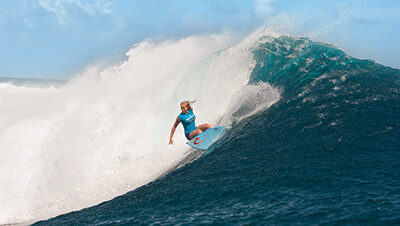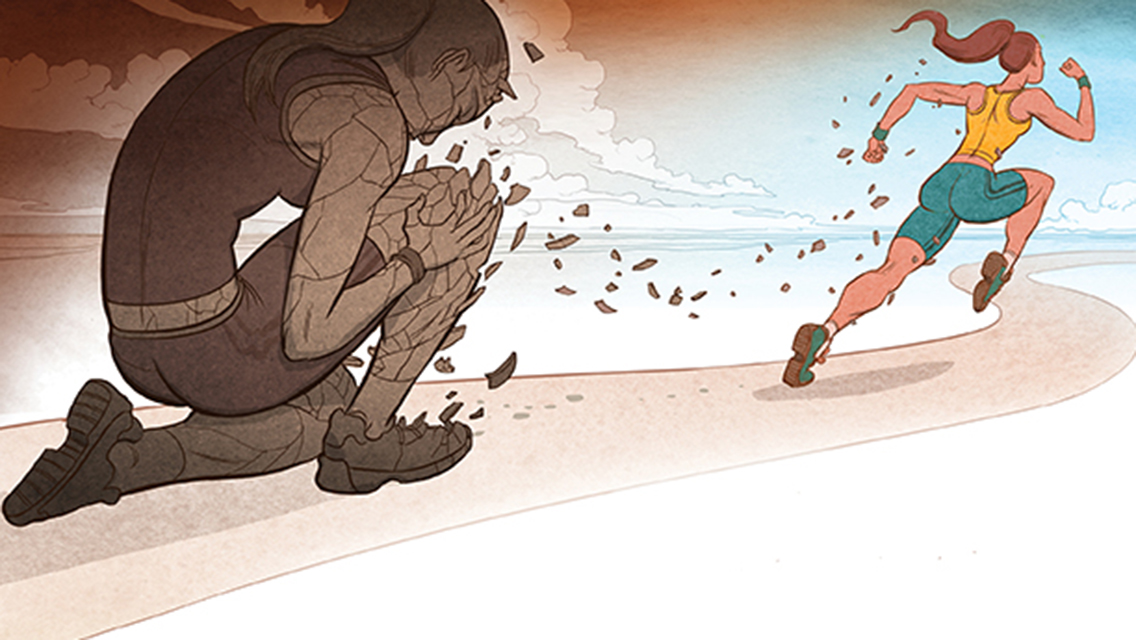Kelsey Peterson had always been an active person. She taught dance and choreographed routines for her students. She was a certified yoga instructor, and she bartended in her spare time.
Her hobbies didn’t look very different from her work. She would go to concerts and dance the night away. She was always carefree, a fun-seeker.
“My body was the focal point of my life,” Kelsey says. It served her in more ways than just helping her earn a living; it was the cornerstone of her spiritual and social identities.
Then everything changed.
Transformative Trauma
Kelsey was living on Madeline Island in northern Wisconsin. It was Fourth of July weekend in 2012, and she was out partying with friends. After the bar closed, they took a friend’s boat to nearby Long Island, which is known for its shallow, warm waters.
Forgetting where she was, Kelsey decided to dive in. The water was 3 feet deep, and she hit her head on the sandy bottom. Immediately, she couldn’t move. She floated up to the surface in slow motion. All she could see was gray. “I thought, This is how I’m going to die,” she says.
Her friend Kris jumped in and saved her, and two other friends helped lift her into the boat. They rushed back to the mainland, where an ambulance was waiting.
Growing Beyond Grief
In the boat, as they sped toward the ambulance, Kelsey looked down at her arms and legs, unable to move them. “I immediately felt a disconnect, like a weird, numbing detachment,” she recalls. “I thought, That is not my body.”
At the hospital in Duluth, Minn., Kelsey learned she had broken her neck in three places, making her a C6 quadriplegic. She had no motor function or sensation below her chest, and she’d lost the use of her triceps, flexors, and hands.
Those first few months were filled with grief, fear, and sadness. Even though her rehabilitation staff was wonderful and nurturing, and even though she had the support of her family and a gorgeous view of Lake Superior, rehab was still frightening.
“Everything was so raw and surreal,” Kelsey says. “I was like a newborn. I thought, How do I bathe myself? How do I put a shirt on? I couldn’t even raise my hands to my face.” It was difficult to feel like a whole person.
Gradually, Kelsey’s life began to change. She started doing water therapy and strength training. She learned how to balance and shift her weight.
In mid-October, she moved to Courage Kenny Rehabilitation Institute, a renowned facility in the Twin Cities. She felt excited to move forward, but also nervous. Rehab at the hospital had been an introduction to the rest of her life, but now she had to learn how to live more independently. It wasn’t just the strength training or skills she was relearning, which were difficult enough — she also had to learn how to work with personal-care assistants (PCAs) and how to get by on her own.
“Before, I was a spontaneous person,” Kelsey says, “and I always trusted I would figure things out as I went along.” But now she had to plan, and she had to be more organized than ever before.
Renewed and Empowered
Rather than a big “aha” moment, Kelsey has had little epiphanies since her injury. “It’s been a gradual awakening,” she says, “a resurfacing.”
Through intense rehabilitation and a regular exercise regimen — and thanks to the full range of motion she has in her shoulders — she’s adapted to use her hands much like a pair of tongs. She can’t feel them, but she can make them useful, and sometimes she surprises herself with what she can do.
Still, she realized early on that she would need to let go of part of who she was: She wouldn’t be able to use her body to express herself. That’s where she had once held so much confidence, creativity, and self-worth; now her spiritual identity, the way she had connected to the world on multiple levels, was gone.
She needed to find another way to feel that creative force pulsing through her. “I needed a new sense of empowerment to replace that part of me that I’d lost,” she says. “And I knew I’d have to figure that out soon and go after it, or I would die inside.”
Kelsey had dabbled in essential oils before her accident, and they became a more vital part of her life in recovery. She started building her apothecary and making body-care products for fun, giving them to friends and family as gifts. It was a new spiritual practice, a way to reconnect with her body.
Eventually, the question arose, Why not do this now? Why not work on her own self-image, self-love, and spirituality by creating a body-care line that was therapeutic, inside and out? That’s when Siren: Therapeutic Skin Rituals was born.
Kelsey says she wants her products to instill a sense of self-care and self-love, and she includes a mantra with each product so people can create their own rituals. “It’s really uplifting to be able to help people by sharing a part of myself,” she says.
Faith in Her Future
Many things have been closed off for Kelsey physically, but that change has allowed other portals to open. She says she notices things in new ways and hears things from her body that she wouldn’t have known how to perceive before.
For instance, she can’t actually feel the reflexology one of her PCAs performs; but, she says, “because I’ve learned to quiet my mind and listen in other ways, I can feel responses in my body, like a wave of calm and energetic pull. It’s an amazing sensation.”
Now, four years after her injury, Kelsey’s biggest daily goal is acceptance. The more she can accept who she is in her new body, the more content she is. “Sometimes I doubt that it’s possible to ever fully accept,” she admits. “There will always be a part of me that wants my body back, no matter how happy I am.”
She says she feels a juxtaposition of loving herself while also hoping for a cure in her lifetime. “How do you balance believing in a cure with accepting where you are right now?” Kelsey asks. She works on that through her involvement with Get Up Stand Up to Cure Paralysis, an organization that is committed to finding medical cures for spinal-cord injuries. She’s not waiting, she says; she’s taking charge.
And she’s still working on gracefully navigating back to a better place. “I’m still trying to relate to the part of me that’s confident and carefree, and I’m trying to see myself as able,” she says. “Even though I’m disabled, I’m still capable of so many things. I’ve had to learn to express the part of me that’s broken so I can resurface and focus on what I still have. I can do this. Life is still good, and I am still me.”
Photography by Madeline Brown
Success Summary
Meet: Kelsey Peterson, 31, owner of Siren: Therapeutic Skin Rituals.
Big Achievements: Accepting and loving who she is in a new way every day
Big Inspiration: “So many people reminded me: I’m still me. My biggest inspiration has been trying to connect to my true essence. I am still capable of having an amazing, extraordinary life.”
What Worked: “The more I think about what I can do, versus what I can’t do and what I’ve lost, the better off I am.”
What Didn’t Work: “Doubting myself, or focusing on the can’t or don’t have.”
Words of Wisdom: “Act out of love instead of fear. The more you can focus on loving yourself and accepting who you are, the better life is going to be.”




This Post Has 0 Comments